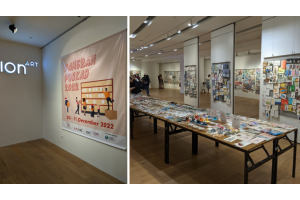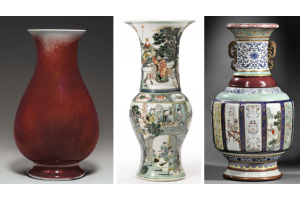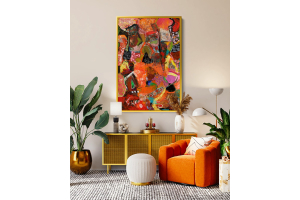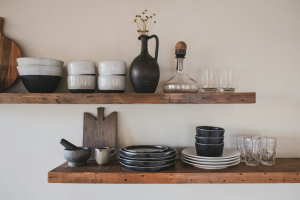How to Sell Paintings Online: A Comprehensive Guide
-
August 24, 2023
Informational

The art market has traditionally been conducted onsite, but in recent times, a growing portion of the art market now includes online art sales. The Covid-19 pandemic caused a significant shift, prompting artists and collectors to sell paintings online more than ever. In fact, online sales value doubled from US$6 billion in 2019 to US$12.4 billion in 2020. This shift spells out good news for both artists and art collectors, as they now have access to a broader range of vendors to sell through.
But, selling paintings online is a lot trickier than selling in person. There are many factors that go into making an online sale, such as: choosing a reliable platform, preparing the artwork for sale, marketing and promoting the art, and properly shipping and handling. Here are a few takeaways that you will need to make your online art presence:
Choosing the Right Platform
There’s so many platforms! Which one do I choose?
Just like how the in-person art market has many different venues, the online market consists of a growing number of platforms. Especially as new websites are being launched every day, you’ll find yourself lost in a sea of digital platforms. The main platforms are your online art galleries, social media marketplaces, and e-commerce platforms. Though each has their own separate set of advantages, it is not a good idea to register under all the platforms. You would find yourself with no time of your own setting up and managing them all, and you could also run into issues such as inventory or multiple buyers purchasing the same painting. Quality is better than quantity.
#MeetArts, an e-commerce platform for selling fine arts. Source: www.meetarts.org.
Audience Targeting
We should look at the audience of each platform. Online art galleries target people interested in art who have extra cash to spare. Social media marketplaces, on the other hand, support a wide variety of products, so only a portion of the audience will be searching for art.
As there are many e-commerce platforms, the audience depends on the platform. Like a social media marketplace, Carousell has many products that aren’t art related, and artists may find it hard for their product to be on the front page. But, there are also art-focused e-commerce platforms. Etsy, for example, targets small business owners, and many of them are arts and craft related. This focus means visitors are more prone to look for art on the website. A small thing to note is that not all platforms are available or are popular globally, so you may want to consider target countries. For example, in Singapore, Carousell is more popular than Amazon as an e-commerce platform.
Cost Considerations: Fees and Commissions
More importantly, we should look at the cost of each platform, in fees and commissions. Each platform has their own set of costs, but in general, online art galleries are the most costly. Saatchi Art, an online art gallery, commissions 35% of the artworks’ price--and that’s considered cheap in the gallery world. Other galleries tend to commission 40-60%, and some have subscription plans to lower these commission rates. On the other hand, the two other platforms are more lenient in costs. Facebook Marketplace, for instance, charges 5% of the product’s price if it exceeds a threshold. Carousell charges a platform fee of 4.5%, but there are additional fees to list more than 30 active products. Just because a platform has lower rates does not mean it is cheaper because you may find hidden fees, paywalls, and subscription plans.
Key Features to Look Out For
While these two are important, you should also look out for other crucial features too. Check whether the platform has a seller protection plan in place. Check for whether the platform is secure before uploading sensitive information. As you’re going to be using this platform, ensure it includes features tailored to you and your paintings.
Here at #MeetArts, we provide a seamless, one-stop shop experience for both our sellers and buyers. Sellers can sell not only a variety of art from paintings to handicrafts but also tickets to art events, with only a small commission fee of 10%. Transactions made on our platform are supported by leading security technology, seller protection, and buyer’s guarantee to ensure smooth shopping experiences. Beside a robust e-commerce page, we also have many content-packed blogs and social media platforms.
Preparing the Artwork for Sale
You’ve finished choosing your platform. Now what?
Now, you have to prepare your artwork to be uploaded. This means preparing your product to look enticing for the buyer that is browsing the products page. This buyer is scrolling through rows and rows of products, so they will be looking at three things to automate their browsing process: the thumbnail of the product, the description, and the price. With just these three things, you have to grab the buyer’s attention, and here’s how to do exactly that.
Thumbnails and Descriptions
A good thumbnail is a high-quality photo of your painting, and that means good lighting, no distortion, no blurriness, and higher resolution. Before you take the picture, you should prepare a setup to shoot your paintings. You could set up outside or indoors, as long as there is a large space that is bright and lit. If you are indoors, you may have to use a lighting rig to adjust the lighting, but if you are outdoors, natural daylight on an overcast day provides the best lighting. Then, you have to set up your artwork. This means leaning it against a wall or using an easel. We suggest the latter as it is stable, secures the painting, and is adjustable for different angles. You can also consider setting up multiple paintings instead of just one to efficiently take their pictures.
A two-lamp setup to reduce shadows. Source: https://cravepainting.com/blog/how-to-take-great-photos-of-your-artwork.
Post-Photography Editing
When you take the picture, try to reduce the shadows cast onto your artwork. This can be done by moving the lighting rigs around or facing the artwork head-on. You can move around as trial and error to find the best spot with little to no shadows.
You should also try to reduce distortion and blurriness. You can do this by setting your camera parallel to the painting, directly in front of it. Unfortunately, every camera lens will have some degree of distortion, so just move the camera a bit back, so you can crop out the distorted edges later. To reduce blurriness, try to hold the camera as stable as possible and lean against a surface to avoid swaying. Or, you can invest in a tripod or camera stand.
Make sure to take many shots because it will be time-consuming to set it all back up again. After you take them, you need to edit your pictures. Crop out the distorted edges and make sure only the entirety of the painting is in frame. Adjust the contrast and color to fix any issues and to make it look as identical as it is in real life. Add a quick sharpening filter to sharpen any details. Then, you can print the image to test how it looks because the colors of the screen and the printed copy may not be identical. Finally, reduce the file size by resizing the artwork because large files will reduce website loading speeds.
Side-by-side comparison of parallel (left) and angled (right) camera shots. Source: https://cravepainting.com/blog/how-to-take-great-photos-of-your-artwork.
Writing a Compelling Description
After all that, you still have to upload your artwork and write a description! When writing a description, be sure to add in the dimensions of the paintings, the materials used, and the inspiration and backstory. Especially in the materials and inspiration, try to be descriptive with keyword-rich phrases and relevant keywords. This is because you want buyers to be able to find your paintings when they search a certain keyword. For example, you can be specific in the materials like oil, watercolor, and so on, or you can include your art style like modern or contemporary. You can also include keywords that are major features in your painting such as rivers, landscapes, and more.
Deciding the Right Price for Your Artwork
You’re at the final step! Here’s where you have to decide on a price. This is one of the most difficult steps because only you will know the time and effort that was put into creating your masterpiece. As such, when you use this as the sole factor in pricing the artwork, buyers may feel that it is overpriced. Instead, when putting a value to the artwork, we have to look at our surroundings. Try to search for similar artists or artworks, and see what they’re pricing their artworks at. The main consideration of price is supply vs demand. Look at the materials, the size, the experience level, and the reputation as well when comparing prices. In addition, you should also factor in the material cost in producing your artwork and the commission fee of the sales channel you are using.
Some artists like to use formulas to price their artwork. One such formula is: 1) multiply the width and the length to get the area in square inches; 2) multiply that by a set amount in proportion to how reputable you are; 3) calculate the cost of your canvas and frame, and double it; 4) add step 2 and 3 together; and 5) try to round down.
Marketing and Promoting Your Art Online
You’ve uploaded your artwork, but you’re not done yet!
Though you’ve done a bit of this when writing the description, you still need to invest more into marketing and promoting yourself. You can do this by developing an online presence through personal websites or social media accounts. Through these methods, you can upload your artworks, and this will serve as not only a portfolio of your art techniques. On your personal website or social media, include your artist statement. This is a first person piece of writing that represents you, narrating what you consider to be most important in your works. When drafting a statement, consider the following: what are the key ideas and goals in your work; what is the thematic focus; what are your influences; what is your process; who is your audience; and most importantly, where are you in your artist’s journey--exploring, uncertain, struggling, or so on.
A description of artist Kaini Zhang from our Art in Action art catalogue.
After you’ve made your online presence, you should promote your artwork. You can increase engagement by interacting with potential buyers. Responding to inquiries and comments will show that you’re active on your platforms. At #MeetArts, we incorporate a live chat feature to enable buyers and sellers to connect in real-time. With saved chat history, real-time chats, and notifications, we hope to make connecting with your audience faster and easier. Beside chats, you should also promote your artwork by sharing your artistic processes with behind the scenes content. This lets your audience be involved in your art, and they will have a stronger connection with your artwork.
Shipping and Handling
You’ve got your first order! What do you do?
Before shipping, you need to safely pack your painting. Here’s a quick step-by-step guide on preparing your painting for shipping:
- Clean up your workspace.
- Measure your painting to get the appropriate shipping box.
- Take out the materials: acid-free tissue paper, kraft paper, blue painter’s tape, cushioning material (i.e., packing peanuts), bubble wrap, cardboard box, two sheets of cardboard, high-quality packing tape.
- If your frame is made of glass, put pieces of blue painter’s tape across the glass to prevent it from breaking and ruining the artwork during the move.
- Wrap your painting in acid-free tissue paper and then in brown kraft paper.
- Sandwich the painting in between two sheets of cardboard for more protection and stability.
- Bubble wrap the sandwich, and seal it with packing tape.
- Fill the bottom with cushioning material.
- Place your artwork in.
- Fill the rest of the space with cushioning material.
- Carefully seal the box with packing tape.
Be sure to take many pictures every step of the way. You should have close-up shots of both sides of the painting and both inside and outside of the box. This is crucial for insurance purposes especially if there’s pre-existing damage to either.
After you’re done handling the package, you should look into available shipping options. Compare the rates of all shipping services, especially if it is international as it can get expensive. Besides the price, you should explore the reviews, safety, and security of the shipping. Misplaced or damaged paintings can incur heavy costs, so make sure the shipping service offers affordable transit protection.
Conclusion
You’ve shipped out your first order. You’ve received your first pay. But you’re still not done yet. To maintain and grow your customer base, it is important to provide a good customer experience through fast, helpful replies, authentic artworks, and carefully handled shipping. Providing a good customer experience will help you accumulate good reviews, letting other interested, potential buyers know that you are a reliable vendor for not just good artworks but also a good experience.
At #MeetArts, we provide a seamless digital platform to handle the administrative processes from profiling you, marketing your artworks to our global network, collecting payment and arranging for the shipping so you have the peace of mind to focus on your art!
References:
- https://blog.artweb.com/how-to/sell-artwork-online-shops-galleries/
- https://www.businessinsider.com/guides/tech/does-facebook-marketplace-charge-fees?op=1
- https://wise.com/sg/blog/sell-in-carousell-singapore#carousell-seller-fees-singapore
- https://support.carousell.com/hc/en-us/articles/360000970147--Singapore-What-is-the-platform-fee-
- https://proactivecreative.com/how-to-photograph-your-artwork/
- https://cravepainting.com/blog/how-to-take-great-photos-of-your-artwork
- https://www.julieerindesigns.com/2023/02/09/seo-for-artists/
- https://www.format.com/magazine/resources/art/how-to-price-your-art
- https://www.artistsnetwork.com/artist-life/a-simple-formula-for-pricing-artwork/
- https://www.uschamber.com/co/grow/marketing/self-promotion-marketing-for-artists
- https://www.artplacer.com/learn-how-to-market-yourself-as-an-artist-in-8-simple-steps/
- https://www.saic.edu/sites/default/files/legacy/Artist_Statement.pdf
- https://fineartshippers.com/how-to-ship-paintings-packing-guide/
- https://fineartshippers.com/the-best-way-to-ship-paintings-safely/
- https://www.artsy.net/article/artsy-editorial-collectors-art-market-2021-report


 PREVIOUS ARTICLE
PREVIOUS ARTICLE 








